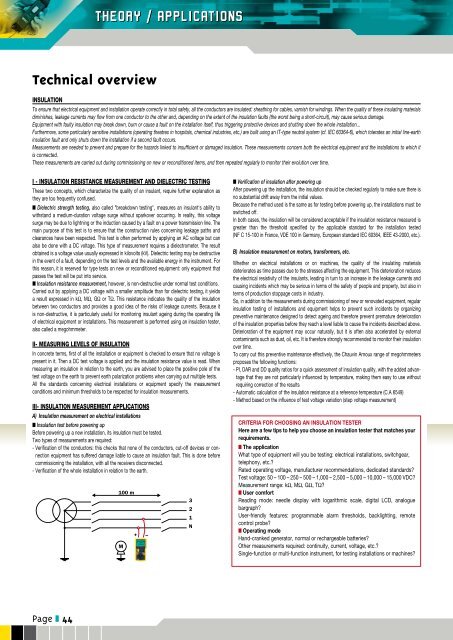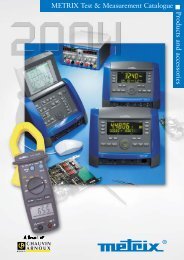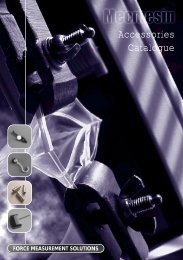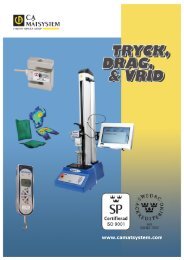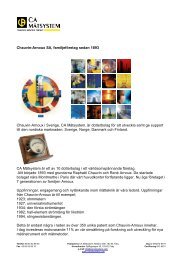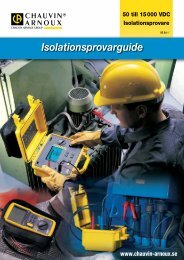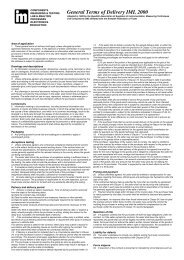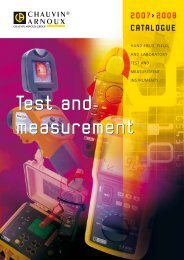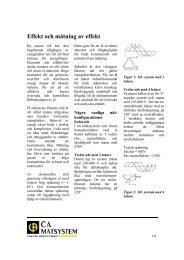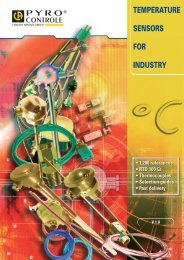Test & Measurement - Chauvin-Arnoux i Skandinavien
Test & Measurement - Chauvin-Arnoux i Skandinavien
Test & Measurement - Chauvin-Arnoux i Skandinavien
Create successful ePaper yourself
Turn your PDF publications into a flip-book with our unique Google optimized e-Paper software.
theorY / applications<br />
Technical overview<br />
insulation<br />
To ensure that electrical equipment and installation operate correctly in total safety, all the conductors are insulated: sheathing for cables, varnish for windings. When the quality of these insulating materials<br />
diminishes, leakage currents may flow from one conductor to the other and, depending on the extent of the insulation faults (the worst being a short-circuit), may cause serious damage.<br />
Equipment with faulty insulation may break down, burn or cause a fault on the installation itself, thus triggering protective devices and shutting down the whole installation...<br />
Furthermore, some particularly sensitive installations (operating theatres in hospitals, chemical industries, etc.) are built using an IT-type neutral system (cf. IEC 60364-6), which tolerates an initial line-earth<br />
insulation fault and only shuts down the installation if a second fault occurs.<br />
<strong>Measurement</strong>s are needed to prevent and prepare for the hazards linked to insufficient or damaged insulation. These measurements concern both the electrical equipment and the installations to which it<br />
is connected.<br />
These measurements are carried out during commissioning on new or reconditioned items, and then repeated regularly to monitor their evolution over time.<br />
I - Insulation resistance measurement and dielectric testing<br />
These two concepts, which characterize the quality of an insulant, require further explanation as<br />
they are too frequently confused.<br />
n Dielectric strength testing, also called "breakdown testing", measures an insulant's ability to<br />
withstand a medium-duration voltage surge without sparkover occurring. In reality, this voltage<br />
surge may be due to lightning or the induction caused by a fault on a power transmission line. The<br />
main purpose of this test is to ensure that the construction rules concerning leakage paths and<br />
clearances have been respected. This test is often performed by applying an AC voltage but can<br />
also be done with a DC voltage. This type of measurement requires a dielectrometer. The result<br />
obtained is a voltage value usually expressed in kilovolts (kV). Dielectric testing may be destructive<br />
in the event of a fault, depending on the test levels and the available energy in the instrument. For<br />
this reason, it is reserved for type tests on new or reconditioned equipment: only equipment that<br />
passes the test will be put into service.<br />
n Insulation resistance measurement, however, is non-destructive under normal test conditions.<br />
Carried out by applying a DC voltage with a smaller amplitude than for dielectric testing, it yields<br />
a result expressed in kΩ, MΩ, GΩ or TΩ. This resistance indicates the quality of the insulation<br />
between two conductors and provides a good idea of the risks of leakage currents. Because it<br />
is non-destructive, it is particularly useful for monitoring insulant ageing during the operating life<br />
of electrical equipment or installations. This measurement is performed using an insulation tester,<br />
also called a megohmmeter.<br />
II- measuring levels of insulation<br />
In concrete terms, first of all the installation or equipment is checked to ensure that no voltage is<br />
present in it. Then a DC test voltage is applied and the insulation resistance value is read. When<br />
measuring an insulation in relation to the earth, you are advised to place the positive pole of the<br />
test voltage on the earth to prevent earth polarization problems when carrying out multiple tests.<br />
All the standards concerning electrical installations or equipment specify the measurement<br />
conditions and minimum thresholds to be respected for insulation measurements.<br />
III- insulation measurement Applications<br />
A) Insulation measurement on electrical installations<br />
n Insulation test before powering up<br />
Before powering up a new installation, its insulation must be tested.<br />
Two types of measurements are required:<br />
- Verification of the conductors: this checks that none of the conductors, cut-off devices or connection<br />
equipment has suffered damage liable to cause an insulation fault. This is done before<br />
commissioning the installation, with all the receivers disconnected.<br />
- Verification of the whole installation in relation to the earth.<br />
100 m<br />
M<br />
+<br />
3<br />
2<br />
1<br />
N<br />
n Verification of insulation after powering up<br />
After powering up the installation, the insulation should be checked regularly to make sure there is<br />
no substantial drift away from the initial values.<br />
Because the method used is the same as for testing before powering up, the installations must be<br />
switched off.<br />
In both cases, the insulation will be considered acceptable if the insulation resistance measured is<br />
greater than the threshold specified by the applicable standard for the installation tested<br />
(NF C 15-100 in France, VDE 100 in Germany, European standard IEC 60364, IEEE 43-2000, etc.).<br />
B) Insulation measurement on motors, transformers, etc.<br />
Whether on electrical installations or on machines, the quality of the insulating materials<br />
deteriorates as time passes due to the stresses affecting the equipment. This deterioration reduces<br />
the electrical resistivity of the insulants, leading in turn to an increase in the leakage currents and<br />
causing incidents which may be serious in terms of the safety of people and property, but also in<br />
terms of production stoppage costs in industry.<br />
So, in addition to the measurements during commissioning of new or renovated equipment, regular<br />
insulation testing of installations and equipment helps to prevent such incidents by organizing<br />
preventive maintenance designed to detect ageing and therefore prevent premature deterioration<br />
of the insulation properties before they reach a level liable to cause the incidents described above.<br />
Deterioration of the equipment may occur naturally, but it is often also accelerated by external<br />
contaminants such as dust, oil, etc. It is therefore strongly recommended to monitor their insulation<br />
over time.<br />
To carry out this preventive maintenance effectively, the <strong>Chauvin</strong> <strong>Arnoux</strong> range of megohmmeters<br />
proposes the following functions:<br />
- PI, DAR and DD quality ratios for a quick assessment of insulation quality, with the added advantage<br />
that they are not particularly influenced by temperature, making them easy to use without<br />
requiring correction of the results<br />
- Automatic calculation of the insulation resistance at a reference temperature (C.A 6549)<br />
- Method based on the influence of test voltage variation (step voltage measurement)<br />
Criteria for choosing an insulation tester<br />
Here are a few tips to help you choose an insulation tester that matches your<br />
requirements.<br />
n The application<br />
What type of equipment will you be testing: electrical installations, switchgear,<br />
telephony, etc.<br />
Rated operating voltage, manufacturer recommendations, dedicated standards<br />
<strong>Test</strong> voltage: 50 – 100 – 250 – 500 – 1,000 – 2,500 – 5,000 – 10,000 – 15,000 VDC<br />
<strong>Measurement</strong> range: kΩ, MΩ, GΩ, TΩ<br />
n User comfort<br />
Reading mode: needle display with logarithmic scale, digital LCD, analogue<br />
bargraph<br />
User-friendly features: programmable alarm thresholds, backlighting, remote<br />
control probe<br />
n Operating mode<br />
Hand-cranked generator, normal or rechargeable batteries<br />
Other measurements required: continuity, current, voltage, etc.<br />
Single-function or multi-function instrument, for testing installations or machines<br />
Page z 44


